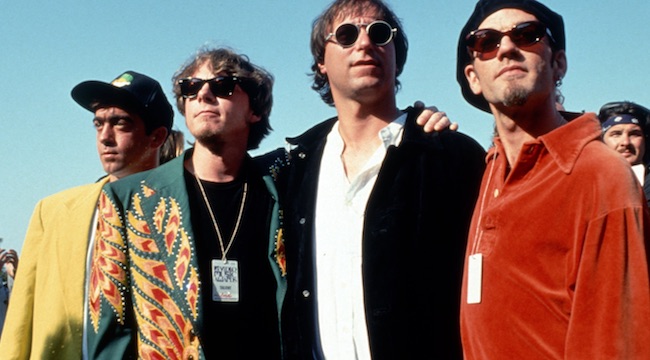
In the spring of 1991, R.E.M. had reached the mountaintop.
Released on March 12, 1991 — just four months shy of the 10th anniversary of the band’s debut single, “Radio Free Europe” — Out Of Time capped a decade-long ascent from indie-rock obscurity in a once-unfashionable corner of the south to the highest echelons of the music industry. On the strength of the smash hit “Losing My Religion,” which peaked at No. 4 on the Hot 100 and stayed on the charts well into summertime, Out Of Time would go on to sell 18 million copies worldwide, including more than four million units in the US alone.
R.E.M. also duked it out with some of the era’s biggest pop stars at the top of the album charts — Out Of Time displaced Mariah Carey’s blockbuster self-titled debut from the No. 1 spot in May, then was briefly ejected by Michael Bolton’s Time, Love, & Tenderness, and then returned to the pole position until Paul Abdul’s Spellbound took it over.
After years of enduring indifferent audiences in pizza parlors and bowling alleys; and mounting countless tours in which the band members had to crash on floors and travel hundreds of miles between gigs inside of tiny vans; and releasing a series of critically acclaimed albums that sold slightly better than the previous one, but never quite took over the zeitgeist; R.E.M had done it. Factoring in record sales, pop success, critical reputation, and artistic quality, they were unquestionably America’s best and most important band in the early ’90s.
The natural order of things is that a band capitalizes on this level of status by launching a lengthy, worldwide concert tour and raking in tens of millions of dollars. At the very least, you splurge on mansions and sports cars, and develop a debilitating drug habit along the way.
But R.E.M. didn’t do any of that. Instead, they acted as if nothing had changed.
After the band completed promotional duties for Out Of Time in May, right when the album was peaking in popularity, guitarist Peter Buck, bassist Mike Mills, and drummer Bill Berry began meeting regularly for few hours each day, five days a week, at a local recording studio in their long-time home of Athens, Georgia. The purpose was to jam, write songs, and record demos for a new R.E.M. album. Over time, dozens of fragments emerged, some of which would later be developed into some of the band’s most beloved songs, while others wouldn’t be heard outside of bootlegs for another 26 years.
“It was no problem for us just to wander down to the studio and hang out for a few hours. It was probably air-conditioned, which was better than half the other places in Athens in the summer,” Mills tells me about the beginning of what became R.E.M.’s greatest album, Automatic For The People.
The last time I interviewed Mike Mills, it was six years ago and R.E.M. had just announced that they were breaking up after 31 years and more than 85 million records sold. Over the course of two phoners, I’ve now spoken to him for a grand total of 40 minutes, so I can’t claim to have deep knowledge of the man. But my impression is that Mills, and R.E.M. generally, is not interested in self-mythology.
When asked about Automatic, Mills dutifully repeats well-trod anecdotes about “Nightswimming,” perhaps the most beautiful rock song ever written about pining for the lost innocence of childhood, for which Mills composed a stirring piano melody set to a preexisting poem written by Michael Stipe. Except Mills can’t remember when he wrote “Nightswimming” — Buck has said in various interviews that it originated from the tail-end of the Out Of Time sessions, which also spawned two other crucial cornerstones of Automatic For The People: The stark, spaghetti-western-style opener “Drive,” and the stunning deathbed lament “Try Not To Breathe.” But Mills can’t confirm the veracity of that story, though he does remember recording the majestic instrumental track at Miami’s Criteria Studios, on the same piano that Jim Gordon used to play the iconic coda to “Layla” 20 years prior. “I just don’t expect anyone else to really care except maybe some muso gearheads that read a lot of liner notes,” Mills says dismissively.
“As far as we were concerned, it was the next record, and really nothing more. That’s really all we were thinking about,” insists Mills, who turns 59 next month. “Part of it was, sitting and writing songs is fun. Whatever you’re doing as a songwriter, you’re hoping a song will pop out of it, even if you’re not directly sitting and saying, ‘Okay, today we’re gonna write a song.’ But if you’re sitting around with a couple of guitars, especially if it’s me and Peter, then the odds are something good’s gonna come out of it.”
The narrative of Automatic For The People that was swiftly set down in initial reviews of the album, and preserved in rock history ever since, is that it is R.E.M’s “mortality” album. And that has almost everything to do with Stipe, who rejoined the other members of R.E.M. in early 1992 after they had created enough music to accommodate a double-album and then some. At that point, Stipe worked as an editor, sifting through the demos and turning the music he liked into songs. It just happened that the music he was most drawn to, as Stipe later explained to Rolling Stone, was “very mid-tempo, pretty fucking weird… more acoustic, more organ-based, less drums.”
“I was thinking a lot about death,” Stipe told NPR last week. “My grandparents were at the end of their lives and I had a sick dog. I know that sounds like nothing, but I was taking care of a dog that was very, very ill. I had [also] spent the better part of the last decade wondering whether I was HIV positive and realizing, finally, I could get anonymous testing after 1987, and knowing that I was healthy and that I had really dodged more than one bullet.”
The most fascinating aspect of listening to the new box set commemorating Automatic For The People‘s 25th anniversary is imagining how different the record might’ve turned out how Stipe been in a different sort of headspace. The demos are revelatory in that regard — there’s the bouncy “Photograph,” presented as both a nebulous work-in-progress and as a fairly fleshed-out could-be-hit-single with Natalie Merchant on backing vocals; “Mike’s Song,” a Mills-sung jangler that harkens back to the band’s mid-’80s period; the bubble-gummy “Peter’s New Song,” which could’ve slotted on Green; and the infectious “Eastern,” a continuation of Out Of Time‘s “sunshine pop” sound.
When I asked Mills about these roads not taken, he again waved his hand. “Too R.E.M.-y,” he says of the unused demos. To be sure, it’s hard to imagine any these songs sitting comfortably on Automatic For The People, no matter the presence of relatively poppy numbers like “The Sidewinder Sleeps Tonight,” a character study about a homeless man that quotes the oldies radio staple “The Lion Sleeps Tonight” by The Tokens, and the bombastic anti-Republican rant “Ignoreland.” Then again, in Mills view, there was nothing inherently death-obsessed about the music before Stipe set it to words.
“The songs were different, but Michael could have taken it in any direction,” he says. “The thing is, whatever the music is, the lyrics can go 180 degrees the other way, so that could have easily happened. But that’s the direction that the music sent Michael — maybe that’s what he was ruminating on at the time anyway. The songs do not dictate the words at all, especially for R.E.M. Michael’s just as likely to write a really sad song over a bouncy pop beat as he is a happy song over a sadder piece. You just never know.
“Here’s the thing,” Mills continues, attempting to impose some reason on my endless string of superlatives for Automatic For The People. “Starting with Reckoning, we expected the next record to be completely disliked and unpopular. So since that didn’t matter, there wasn’t a whole lot of pressure. We just went in and had fun and made the record we wanted.”
And, for Mills, that’s that. But not for me.
Automatic For The People is one of the great records of the last 25 years for many reasons, but let’s start with the mythos that surrounded the band at the time.
From R.E.M.’s perspective, the decision to not tour behind Out Of Time, even as the album went on to collect VMAs and Grammys through the end of 1991 and into early ’92, merely stemmed from a desire to maintain a well-established working routine. “We think of what we do in a really nonromantic way,” said Buck, who likened the band to “shlubs that bang out some chords” with 9-to-5 regularity, in a 1992 Spin interview. “If I were a furniture builder or something, you’d probably ask why I made so many tables.”
But for R.E.M. fans and the media, this inaccessibility only heightened the band’s mystique. This aspect of R.E.M. in the early ’90s can be difficult to explain to someone who only knows our modern, internet-saturated world, in which pop stars never really go away, unless you count the hours between tweets and Instagram posts as mini-hiatuses.
The precedents for what R.E.M. did between Out Of Time and Automatic For The People date back to the late ’60s, when the Beatles retreated from the road and hibernated for several months inside of Abbey Road in order to make Sgt. Pepper’s Lonely Hearts Club Band; and Bob Dylan, who absconded to upstate New York in the wake of a motorcycle accident to record dozens of songs with The Band, later released as The Basement Tapes, and then Nashville to make the enigmatic, Bible-quoting John Wesley Harding.
Like the Dylan record, Automatic For The People was out-of-step with what was happening in rock at the time — a quiet, mournful crucible placed gently amid thunderous power-chords played by burly men who looked like lumberjacks. In the 19 months that separated Out Of Time and Automatic For The People, grunge bands had become the rage on MTV. The new all-flannel dress code was like a photo negative of the multi-colored Arsenio Hall suits that R.E.M. donned in the video for “Shiny Happy People.”
Meanwhile, the generation of bands that R.E.M. had come up with in the ’80s was disappearing. On July 4, 1991, The Replacements — the Goofus to R.E.M.’s Gallant in the American indie underground — played their final show of the 20th century at Grant Park in Chicago, walking off stage in a dispirited, exhausted snit amid squalls of feedback and curse words. Part of the Replacements’ failure (and, their fans would forever insist, their charm) was the band’s inability to navigate its career as smartly as R.E.M. had. The ‘Mats didn’t know how to survive and thrive. But what happens after you survive?
The first single from Automatic, “Drive,” underlined R.E.M.’s separation both from their own peers, who no longer were R.E.M.’s peers given the band’s newly minted superstardom, and the latest generation of alt-rock upstarts led by Nirvana and Pearl Jam. The song opens with Buck’s spindly guitar picking and Mills’ insistently melodic bass. When Buck leans into a strum, it sounds thick and heavy — instead of using a pick Buck played with a penny, a trick originally utilized by Brian May of Queen, who liked how it made his guitar strings sound sturdier and dirtier.
Immediately, it’s apparent that this isn’t the jangly, low-budget R.E.M. of the ’80s — Automatic For The People was a classic rock record made by jet-setting rock stars who worked in several different studios scattered throughout America, with string parts arranged by none other than John Paul Jones, whose arrangements on songs like “Drive” and “Nightswimming” provide a sense of sweep that’s reminiscent of Led Zeppelin III.
“Hey kids, rock and roll, nobody tells you where to go,” Stipe sings — a reference to David Essex’s 1973 glitter-pop hit “Rock On,” but more important is the distinction Stipe makes between himself, a 32-year-old man at the time of Automatic‘s release, and young people. He’s talking to kids, not among them.
When Automatic For The People is discussed as a “death” record, I suspect it’s because of “Everybody Hurts” — a late-night ’60s soul burner presented in the guise of an earnest power-ballad that started as a bare bones Bill Berry demo and was transformed by Stipe into the “Bridge Over Troubled Water” of Generation X — and the breathtaking trilogy of tunes that close the record: “Man On The Moon,” “Nightswimming,” and “Find The River.”
Often when I listen to Automatic For The People, I’m convinced that R.E.M. peaked with that emotionally overpowering closing triptych, which replicates the sensation of an entire life passing by in the flashpoint of a final breath. There’s a prayer hoping for the existence of God (“Man On The Moon”), the remembrance of days gone by (“Nightswimming”), and gentle prodding toward an impossibly warm, welcoming white light (“Find The River”). It’s as though I die a little, and then feel reborn, each time I hear it.
But that’s not the entire record or even, exactly, its essence. I’ve come to hear Automatic For The People as an album informed by R.E.M.’s (more specifically Stipe’s) burgeoning fame, and the desire to carve out an island of sanity and inner peace amid rampant pressure and lots of external insanity.
Again, this can be difficult to contextualize for those who have been conditioned to expect perpetual public exposure not just from their favorite musicians, but also their friends and even themselves. But for R.E.M., a band that thrived for years in a sleepy southern college town that might as well not even existed in the early ’80s (as far as New York or Los Angeles were concerned), celebrity crept in as a slowly destabilizing force that gradually became the primary subject of Stipe’s songs as the ’90s unfolded.
It’s hard to overstate just how famous Stipe was in the early ’90s. He was certainly a big enough celebrity to experience the bad parts of fame — in 1991 and ’92 his world was rocked by persistent rumors that he was HIV positive, fueled by R.E.M.’s absence from the concert stage. Stipe even, reportedly, hired a private detective to uncover the source of the rumors, though he didn’t want to publicly deny the story, for fear of stigmatizing those actually living with the disease.
Unlike subsequent R.E.M. albums like 1994’s Monster, which is populated by dead-eyed celebrity stalkers and vacuous talk-show media vultures, or 1996’s New Adventures In Hi-Fi, where the exhaustion of an endless tour can be heard in Stipe’s weathered vocals and the bombed-out arena-rock arrangements, Automatic For The People represents a moment when R.E.M. was able to temporarily maintain a safe space away from the outside world. And they used that space to meditate on all of the profound, unanswerable questions that a hero must ponder the morning after he walks off into the sunset, when his dreams have been fulfilled and yet he finds that his life is still proceeding inexorably toward a dark and mysterious destination.
Was living in Athens in the wake of Out Of Time‘s massive success as though they were merely “shlubs that bang out some chords” an act of self-preservation? Or was it delaying the inevitable? What Automatic For The People ultimately mourns is the version of R.E.M. that existed when life was smaller and more manageable. For the time being, they could act as they were still humble, workmanlike furniture makers who just happened to constantly be on the radio and MTV. But the ache that reverberates throughout Stipe’s songs betrays a feeling of deep sadness and uncertainty over what has been lost.
Each member of R.E.M. reacted to success in his own way. Mills stayed focused on the work. Berry bought a farm and started to extricate himself from the band, culminating with his official departure in 1997. Buck, whose first marriage began to fall apart in 1991, carried on the nomadic life of a touring musician without an actual tour to play, traveling solo on road trips and staying in cheap hotels.
Stipe became a big-brother figure for the most reluctant stars in the alt-rock galaxy, starting with Kurt Cobain, who sought Stipe’s advice and regarded R.E.M. as a model for his own band. “I don’t know how that band does what they do. God, they’re the greatest. They’ve dealt with their success like saints, and they keep delivering great music,” Cobain told Rolling Stone in 1994, his last major interview with the magazine.
Cobain wanted Nirvana’s next album to sound like Automatic For The People, and in a way he got his wish — the posthumous MTV Unplugged In New York has a similarly funereal, chamber-folk vibe. While Cobain never spoke about the song publicly, “Sweetness Follows,” in particular, seems like it probably influenced Cobain in terms of where he wanted to take his music. The song’s aesthetic is virtually the same as that of MTV Unplugged In New York — briskly strummed acoustic guitar, heavy-churning cello, beautifully weary vocals, an undercurrent of electric feedback, and lyrics that address death with a resignation pitched somewhere between expectant and entreating.
“Sweetness Follows” is my favorite song on Automatic For The People, and sometimes I think it might be my favorite R.E.M. song ever, even if you can’t hear Mills or Berry on it. While my other favorite R.E.M. tunes have inevitability come to sound familiar, “Sweetness Follows” always seems fresh and enigmatic, like a Zen koan you don’t literally understand but whose emotional truths you nonetheless grasp intuitively. “It’s these little things, they can pull you under / Live your life filled with joy and wonder / I always knew this altogether thunder / Was lost in our little lives.” What does that mean? I’m not sure. But I know I want “Sweetness Follows” to be played at my funeral.
Part of the lore of Automatic For The People is that it was supposedly the last album that Cobain listened to before (or, perhaps, as) he killed himself. I don’t bring this up as some sort of morbid endorsement, but rather to underline how the members R.E.M. were able to recover the safe space they created on this record for themselves, even as many of their friends collapsed under the weight of fame. In 2011, they chose to step away from one of the most successful bands of the last 30 years and into lives of relative anonymity. Mills and Buck continue to make records and tour with a minimum amount of publicity and fanfare. Berry is still on his farm. Stipe occasionally steps out to perform publicly, but he doesn’t seek out the spotlight.
They are, by rock-star standards, “normal” people. “We’re all really good friends and so we were watching out for each other,” Stipe told me in 2014. “If there was anything that was super harmful or just seemed like someone was trailing down the wrong way, the other guys would pull you back and snap you back into reality.”
While R.E.M. is no longer a band, you sense that they’re still holding each other in check. They remain allergic to anything that remotely reeks of bullshit, even when a fan tries to express how much an album like Automatic For The People still means to him.
“You try to keep perspective on this,” Mills tells me near the end of our interview. “Yes, our music is influential and has made a big difference in people’s lives, but we’re still just guys making music. You try to keep a good balance on that, and we usually didn’t have a problem keeping that balance.”
I can’t argue. Balance is important. It’s what keeps these little things from pulling you under.






